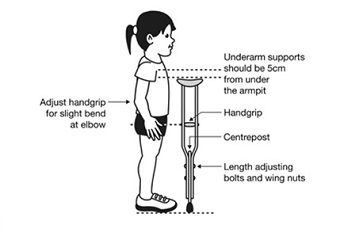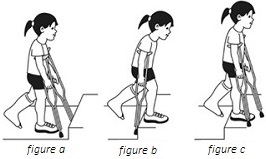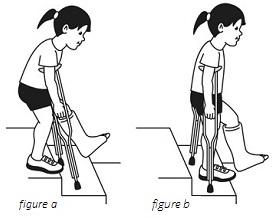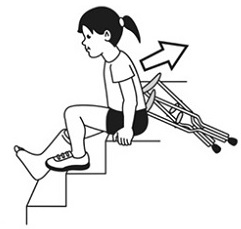Crutches can help your child recover more quickly from leg, foot or ankle injuries, by reducing the amount of weight placed on the injured leg. Encourage your child to take things slowly at first and learn how to use their crutches properly. It can be easy for
children to fall or lose their balance while using crutches.
Not all young children will be able to use crutches, and very few younger than seven. If your child is not coordinated enough to use crutches, or if you have any doubts, please ensure they do not use crutches. Your GP or physiotherapist can suggest alternatives.
Adjusting the crutches
To make sure the crutches fit your child correctly:
- Ask your child to stand up straight, and measure them from the armpit to the floor. Take 5 cm off this and you have the correct crutch length, e.g. if the height from your child's armpit to the floor is 90 cm, the crutch should be 85 cm high. (If your child is
unable to stand safely, you can take the measurements while they are lying down).
Adjust the handgrip height so the elbow bends slightly when your child is standing relaxed.
Make sure the crutches are safe to use by checking the wing nuts are tight and that the crutch tips (the rubber stoppers at the bottom of the crutches) are securely attached and not worn.

Your child is now ready to walk on their crutches as they have been shown. They should wear non-slip shoes (e.g. runners). Your physiotherapist, doctor or nurse will have told you and your child how much weight they can put on the sore leg.
How to use crutches
Make sure your child is standing up straight and balanced before trying to use the crutches. Their feet should be slightly apart. The crutches need to be out to the side (about 10 to 15 cm) and slightly in front of their feet.
Your child should:
- hold the handgrip firmly to their side by pressing their upper arms against their body (the elbows should be slightly bent)
- move both crutches out in front of their body (make sure the crutches are not placed too far in front or too far apart from each other)
- balance their weight on their hands and push down onto the crutch handles (make sure they lean on their hands, not their armpits)
- bring their good leg up to or just past the crutches – this will move them forward.
If they are not allowed to bear weight on their sore leg, make sure they keep it off the ground.
If they are able to take some weight, they can put their sore leg on the ground and place some weight on it. Their hands should take the rest of their weight.
If your child is having difficulty using crutches, a physiotherapist can ensure the crutches are sized correctly and will teach your child how best to use them.
Sitting down or standing up with crutches
Your child should:
- hold the crutches in one hand, by the crutch handles
- place their sore leg forward
- grip the seat with their other hand
- lean forward, gently bend their good leg and lower themselves onto the seat; or
- gently straighten their good leg and push themselves up from the seat.
Using crutches with stairs
Navigating stairs is one of the trickiest parts of using crutches.
If your child is not allowed to bear weight on their sore leg, they will need to follow these steps when using stairs.
Parents/carers should always position themselves close to the child to steady them if required.
|
Going up: "Good foot, sore foot, crutches"
|
|
Your child should:
- walk right up to the step (figure a)
- pushing through their arms, lean forward and bring their weight over the crutches, and then hop onto the first step with their good foot (figure b)
- straighten their body while bringing their crutches and sore leg up onto the step
- continue this process carefully up the stairs (figure c).
|

|
|
Going down: "Crutches, sore foot, good foot"
|
|
Your child should:
- walk right to the edge of the step
- place their crutches carefully down to the step below
- move their sore foot out in front of the crutches and lean slightly forward, then let the crutches carry their weight (figure a)
- pushing firmly through the crutches, step down onto the good leg (figure b)
- continue this process slowly and carefully down the stairs.
|
 |
If your child feels unsafe using crutches on stairs, they can sit on the step and go up or down on their bottom.

Another alternative is to temporarily relocate their sleeping spot rather than frequently using the staircase, depending on your child's age and coordination.
Key points to remember
- Your child should take things slowly at first and learn how to use the crutches properly.
- Your child's weight should be on their hands, not on their armpits.
- Make sure the crutches are not placed too far in front of their body or too far apart from each other.
- Special care is needed going up and down stairs. A parent or carer should be close by to steady your child if needed. If it doesn't feel safe, your child should go up or down stairs on their bottom.
For more information
- Contact your local emergency department, physiotherapy, GP or practice nurse.
Common questions our doctors are asked
How long will my child need to use crutches?
This depends on how serious your child's injury is and how quickly they recover. If in doubt, ask your physiotherapist, GP, or orthopaedic surgeon (bone doctor). Make sure you follow medical advice and take your child to all their follow-up appointments.
My child feels it is easier to have the top of the crutch right under the armpit and lean on it, why is that not recommended?
Having crutches set too tall so that part of the weight is born through the armpit compresses one of the important nerves to the arm, and can cause longer-term problems. The top part of the crutches are really just for stability - weight should be carried via the handles.
Developed by The Royal Children's Hospital Physiotherapy and Emergency Medicine departments. We acknowledge the input of RCH consumers and carers.
Reviewed August 2020.
Kids Health Info is supported by The Royal Children’s Hospital Foundation. To donate, visit
www.rchfoundation.org.au.